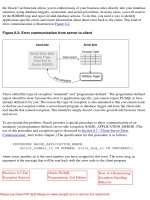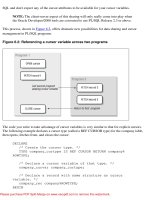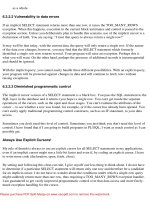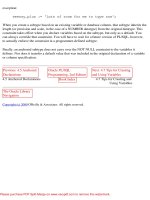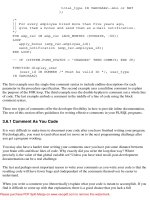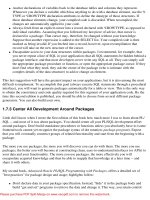oracle and sql manual
Bạn đang xem bản rút gọn của tài liệu. Xem và tải ngay bản đầy đủ của tài liệu tại đây (2.99 MB, 394 trang )
SQL*Plus®
User’s Guide and Reference
Release 8.1.6
October, 1999
Part No. A75664-01
SQL*Plus User’s Guide and Reference, Release 8.1.6
Part No. A75664-01
Copyright © 1996, 1999, Oracle Corporation. All rights reserved.
Contributing Authors: Larry Baer, Lisa Colston, Roland Kovacs, Karen Denchfield-Masterson, Alison
Holloway, Sanjeev Jhala, Christopher Jones, Anita Lam, Nimish Mehta, Luan Nim, Bud Osterberg, Irene
Paradisis, Richard Rendell, Frank Rovitto, Farokh Shapoorjee, Larry Stevens, Andre Touma, Simon Watt
The Programs (which include both the software and documentation) contain proprietary information of
Oracle Corporation; they are provided under a license agreement containing restrictions on use and
disclosure and are also protected by copyright, patent, and other intellectual and industrial property
laws. Reverse engineering, disassembly, or decompilation of the Programs is prohibited.
The information contained in this document is subject to change without notice. If you find any problems
in the documentation, please report them to us in writing. Oracle Corporation does not warrant that this
document is error free. Except as may be expressly permitted in your license agreement for these
Programs, no part of these Programs may be reproduced or transmitted in any form or by any means,
electronic or mechanical, for any purpose, without the express written permission of Oracle Corporation.
If the Programs are delivered to the U.S. Government or anyone licensing or using the programs on
behalf of the U.S. Government, the following notice is applicable:
Restricted Rights Notice Programs delivered subject to the DOD FAR Supplement are "commercial
computer software" and use, duplication, and disclosure of the Programs including documentation, shall
be subject to the licensing restrictions set forth in the applicable Oracle license agreement. Otherwise,
Programs delivered subject to the Federal Acquisition Regulations are "restricted computer software"
and use, duplication and disclosure of the Programs shall be subject to the restrictions in FAR 52.227-19,
Commercial Computer Software - Restricted Rights (June, 1987). Oracle Corporation, 500 Oracle
Parkway, Redwood City, CA 94065.
The Programs are not intended for use in any nuclear, aviation, mass transit, medical, or other inherently
dangerous applications. It shall be the licensee's responsibility to take all appropriate fail-safe, back up,
redundancy, and other measures to ensure the safe use of such applications if the Programs are used for
such purposes, and Oracle disclaims liability for any damages caused by such use of the Programs.
Oracle is a registered trademark, and JDeveloper, Oracle Designer, Oracle Developer, Oracle Discoverer,
Oracle7, Oracle8, Oracle8i, Oracle Media Objects, Oracle Mobile Agents, Oracle Application Server,
PL/SQL, Oracle Programmer, SQL*Forms, Net8 and SQL*Plus are trademarks or registered trademarks
of Oracle Corporation. All other company or product names mentioned are used for identification
purposes only and may be trademarks of their respective owners.
iii
Contents
Send Us Your Comments xi
Preface xiii
Part I Understanding SQL*Plus
1 Introduction
Overview of SQL*Plus 1-2
Basic Concepts 1-2
Who Can Use SQL*Plus 1-2
Other Ways of Working with Oracle 1-3
Using this Guide 1-4
Conventions for Command Syntax 1-4
Sample Tables 1-5
What You Need to Run SQL*Plus 1-6
Hardware and Software 1-6
Information Specific to Your Operating System 1-7
Username and Password 1-7
Access to Sample Tables 1-8
2 Learning SQL*Plus Basics
Getting Started 2-2
Using the Keyboard 2-2
Starting SQL*Plus 2-3
iv
Leaving SQL*Plus 2-4
Entering and Executing Commands 2-5
Running SQL Commands 2-6
Running PL/SQL Blocks 2-10
Running SQL*Plus Commands 2-11
Variables that Affect Running Commands 2-13
Saving Changes to the Database Automatically 2-13
Stopping a Command while it is Running 2-15
Collecting Timing Statistics on Commands You Run 2-15
Running Host Operating System Commands 2-15
Getting Help 2-16
Listing a Table Definition 2-16
Listing PL/SQL Definitions 2-17
Controlling the Display 2-17
Interpreting Error Messages 2-17
3 Manipulating Commands
Editing Commands 3-2
Listing the Buffer Contents 3-3
Editing the Current Line 3-4
Adding a New Line 3-5
Appending Text to a Line 3-6
Deleting Lines 3-7
Editing Commands with a System Editor 3-8
Saving Commands for Later Use 3-8
Storing Commands in Command Files 3-8
Placing Comments in Command Files 3-12
Retrieving Command Files 3-13
Running Command Files 3-14
Nesting Command Files 3-16
Modifying Command Files 3-16
Exiting from a Command File with a Return Code 3-17
Setting Up Your SQL*Plus Environment 3-17
Storing and Restoring SQL*Plus System Variables 3-18
Writing Interactive Commands 3-19
v
Defining User Variables 3-20
Using Substitution Variables 3-20
Passing Parameters through the START Command 3-25
Communicating with the User 3-27
Using Bind Variables 3-30
Creating Bind Variables 3-30
Referencing Bind Variables 3-31
Displaying Bind Variables 3-31
Using REFCURSOR Bind Variables 3-32
Tracing Statements 3-35
Controlling the Report 3-35
Execution Plan 3-36
Statistics 3-37
Tracing Parallel and Distributed Queries 3-39
4 Formatting Query Results
Formatting Columns 4-2
Changing Column Headings 4-2
Formatting NUMBER Columns 4-4
Formatting Datatypes 4-6
Copying Column Display Attributes 4-8
Listing and Resetting Column Display Attributes 4-9
Suppressing and Restoring Column Display Attributes 4-9
Printing a Line of Characters after Wrapped Column Values 4-10
Clarifying Your Report with Spacing and Summary Lines 4-11
Suppressing Duplicate Values in Break Columns 4-12
Inserting Space when a Break Column’s Value Changes 4-13
Inserting Space after Every Row 4-14
Using Multiple Spacing Techniques 4-14
Listing and Removing Break Definitions 4-15
Computing Summary Lines when a Break Column’s Value Changes 4-16
Computing Summary Lines at the End of the Report 4-20
Computing Multiple Summary Values and Lines 4-21
Listing and Removing COMPUTE Definitions 4-22
Defining Page and Report Titles and Dimensions 4-23
vi
Setting the Top and Bottom Titles and Headers and Footers 4-23
Displaying the Page Number and other System-Maintained Values in Titles 4-28
Listing, Suppressing, and Restoring Page Title Definitions 4-29
Displaying Column Values in Titles 4-30
Displaying the Current Date in Titles 4-32
Setting Page Dimensions 4-32
Storing and Printing Query Results 4-35
Sending Results to a File 4-36
Sending Results to a Printer 4-36
Creating Web Reports 4-38
Creating Web Reports Interactively 4-38
HTML Entities 4-42
Creating Embedded Web Reports 4-42
Suppressing the Display of SQL*Plus Commands in Web Reports 4-45
5 Database Administration
Overview 5-2
Introduction to Database Startup and Shutdown 5-2
Database Startup 5-2
Database Shutdown 5-3
Redo Log Files 5-4
ARCHIVELOG Mode 5-4
Database Recovery 5-5
6 Accessing SQL Databases
Connecting to the Default Database 6-2
Connecting to a Remote Database 6-2
Connecting to a Remote Database from within SQL*Plus 6-3
Connecting to a Remote Database as You Start SQL*Plus 6-3
Copying Data from One Database to Another 6-4
Understanding COPY Command Syntax 6-4
Controlling Treatment of the Destination Table 6-6
Interpreting the Messages that COPY Displays 6-8
Specifying Another User’s Table 6-8
Copying Data between Tables on One Database 6-8
vii
Part II Reference
7 Starting SQL*Plus and Getting Help
Starting SQL*Plus Using the SQLPLUS Command 7-2
Setting Up the Site Profile 7-8
Setting Up the User Profile 7-8
Getting Help 7-10
8 Command Reference
SQL*Plus Command Summary 8-2
@ ("at" sign) 8-5
@@ (double "at" sign) 8-7
/ (slash) 8-9
ACCEPT 8-10
APPEND 8-12
ARCHIVE LOG 8-14
ATTRIBUTE 8-18
BREAK 8-20
BTITLE 8-25
CHANGE 8-26
CLEAR 8-29
COLUMN 8-31
COMPUTE 8-41
CONNECT 8-47
COPY 8-49
DEFINE 8-52
DEL 8-54
DESCRIBE 8-56
DISCONNECT 8-63
EDIT 8-64
EXECUTE 8-66
EXIT 8-67
GET 8-69
HELP 8-70
viii
HOST 8-71
INPUT 8-72
LIST 8-74
PASSWORD 8-76
PAUSE 8-77
PRINT 8-78
PROMPT 8-79
RECOVER 8-81
REMARK 8-87
REPFOOTER 8-88
REPHEADER 8-90
RUN 8-94
SAVE 8-95
SET 8-97
SHOW 8-124
SHUTDOWN 8-129
SPOOL 8-131
START 8-132
STARTUP 8-134
STORE 8-138
TIMING 8-139
TTITLE 8-141
UNDEFINE 8-145
VA R I A B LE 8-146
WHENEVER OSERROR 8-152
WHENEVER SQLERROR 8-154
ix
A COPY Command Messages and Codes
B Release 8.1.6 Enhancements
C SQL*Plus Limits
D SQL Command List
E Security
F Obsolete SQL*Plus Commands
Glossary
Index
x
xi
Send Us Your Comments
SQL*Plus User’s Guide and Reference, Release 8.1.6
Part No. A75664-01
Oracle Corporation welcomes your comments and suggestions on the quality and usefulness of this
publication. Your input is an important part of the information used for revision.
■ Did you find any errors?
■ Is the information clearly presented?
■ Do you need more information? If so, where?
■ Are the examples correct? Do you need more examples?
■ What features did you like most about this manual?
If you find any errors or have any other suggestions for improvement, please indicate the chapter,
section, and page number (if available). You can send comments to us in the following ways:
■ Electronic mail:
■ FAX: +61 3 9690 0043 Attention: SQL*Plus Documentation Manager
■ Postal service:
SQL*Plus Documentation Manager,
Australian Product Development Center,
Oracle Corporation Australia Pty Ltd,
324 St. Kilda Road,
Melbourne, VIC 3004,
Australia
If you would like a reply, please give your name, address, and telephone number below.
If you have problems with the software, please contact your local Oracle Support Services center.
xii
xiii
Preface
The SQL*Plus (pronounced "sequel plus") User’s Guide and Reference introduces the
SQL*Plus program and its uses. It also provides a detailed description of each
SQL*Plus command.
xiv
Audience
This Guide addresses business and technical professionals who have a basic
understanding of the SQL database language. If you do not have any familiarity
with this database tool, you should refer to the Oracle8i SQL Reference. If you plan to
use the PL/SQL database language in conjunction with SQL*Plus, refer to the
PL/SQL User’s Guide and Reference for information on using PL/SQL.
How to Use this Guide
Refer to the following tables for a list of topics covered by this Guide, a description
of each topic, and the number of the chapter that covers the topic.
PART I, Understanding SQL*Plus
Topic Description
Chapter
Number
Introduction Gives an overview of SQL*Plus, instructions
on using this Guide, and information on
what you need to run SQL*Plus.
1
Learning SQL*Plus
Basics
Explains how to start SQL*Plus and enter
and execute commands. You learn by
following step-by-step examples using
sample tables.
2
Manipulating
Commands
Also through examples, helps you learn to
edit commands, save them for later use, and
write interactive commands.
3
Formatting Query
Results
Explains how you can format columns,
clarify your report with spacing and
summary lines, define page dimensions and
titles, store and print query results, and
output query results to the web. Also uses
step-by-step examples.
4
Database
Administration
This chapter is intended for use by DBAs,
and covers the basic database
administration features in SQL*Plus.
5
xv
PART II, Reference
Topic Description
Chapter
Number
Accessing
Databases
Tells you how to connect to default and
remote databases, and how to copy data
between databases and between tables on
the same database.
6
Starting SQL*Plus
and Getting Help
Explains how to access SQL*Plus from the
operating system prompt, and how to access
online help.
7
Command
Reference
Gives you a SQL*Plus command summary
and detailed descriptions of each SQL*Plus
command in alphabetical order.
8
COPY Command
Messages and
Codes
Lists copy command error messages, their
causes, and appropriate actions for error
recovery.
Appendix A
Release 8.1.6
Enhancements
Describes enhancements to SQL*Plus in
release 8.1.6.
Appendix B
SQL*Plus Limits Lists the maximum values for elements of
SQL*Plus.
Appendix C
SQL Command List Provides a list of major SQL commands and
clauses.
Appendix D
Security Explains how to restrict access to certain
SQL*Plus and SQL commands.
Appendix E
Obsolete SQL*Plus
Commands
Provides information on Obsolete SQL*Plus
commands.
Appendix F
Glossary Defines technical terms associated with
Oracle and SQL*Plus.
Glossary
xvi
Related Publications
Related documentation includes the following publications:
■ SQL*Plus Quick Reference
■ PL/SQL User’s Guide and Reference
■ Oracle8i SQL Reference
■ Oracle8i Concepts
■ Oracle8i Administrator’s Guide
■ Oracle8i Backup and Recovery Guide
■ Oracle8i Application Developer’s Guide - Fundamentals
■ Oracle8i Distributed Database Systems
■ Oracle8i Replication
■ Oracle8i Utilities
■ Oracle8i Error Messages
■ Oracle8i Migration
■ Oracle8i Reference
■ Oracle8i Designing and Tuning for Performance
■ Oracle8i Parallel Server Concepts
■ Net8 Administrator’s Guide
■ Oracle Call Interface Programmer’s Guide
■ Pro*COBOL Precompiler Programmer’s Guide
■ Pro*C/C++ Precompiler Programmer’s Guide
■ Oracle installation and user’s manual(s) provided for your operating system
xvii
Your Comments Are Welcome
Oracle Corporation values and appreciates your comments as an Oracle user and
reader of the manuals. As we write, revise, and evaluate, your opinions are the most
important input we receive. There is a form entitled "Send Us Your Comments"
following that we encourage you to use to tell us both what you like and what you
dislike about this (or other) Oracle manuals. If the form is not at the front of this
manual, or if you would like to contact us, please use the following addresses and
phone numbers.
For documentation questions/comments, contact:
SQL*Plus Documentation Manager
Australian Product Development Center
Oracle Corporation Australia Pty Limited
324 St. Kilda Road
Melbourne VIC 3004
Australia
+61 3 9209 1600 (telephone)
+61 3 9690 0043 (fax)
(email)
For product questions/comments, contact:
SQL*Plus Product Manager
Australian Product Development Center
Oracle Corporation Australia Pty Limited
324 St. Kilda Road
Melbourne VIC 3004
Australia
+61 3 9209 1600 (telephone)
+61 3 9690 0043 (fax)
(email)
xviii
Part I
Understanding SQL*Plus
This section provides an introduction to SQL*Plus. It provides an overview of how
to run SQL*Plus and demonstrates this with various examples.
The following chapters are covered in this section:
■ Introduction
■ Learning SQL*Plus Basics
■ Manipulating Commands
■ Formatting Query Results
■ Database Administration
■ Accessing SQL Databases
Introduction 1-1
1
Introduction
This chapter introduces you to SQL*Plus, covering the following topics:
■ Overview of SQL*Plus
■ Using this Guide
■ What You Need to Run SQL*Plus
Overview of SQL*Plus
1-2 SQL*Plus User’s Guide and Reference
Overview of SQL*Plus
You can use the SQL*Plus program in conjunction with the SQL database language
and its procedural language extension, PL/SQL. The SQL database language allows
you to store and retrieve data in Oracle. PL/SQL allows you to link several SQL
commands through procedural logic.
SQL*Plus enables you to execute SQL commands and PL/SQL blocks, and to
perform many additional tasks as well. Through SQL*Plus, you can
■ enter, edit, store, retrieve, and run SQL commands and PL/SQL blocks
■ format, perform calculations on, store, print and create web output of query
results
■ list column definitions for any table
■ access and copy data between SQL databases
■ send messages to and accept responses from an end user
■ perform database administration
Basic Concepts
The following definitions explain concepts central to SQL*Plus:
Who Can Use SQL*Plus
The SQL*Plus, SQL, and PL/SQL command languages are powerful enough to
serve the needs of users with some database experience, yet straightforward enough
for new users who are just learning to work with Oracle.
command An instruction you give SQL*Plus or Oracle.
block A group of SQL and PL/SQL commands related to one
another through procedural logic.
table The basic unit of storage in Oracle.
query A SQL command (specifically, a SQL SELECT command) that
retrieves information from one or more tables.
query results The data retrieved by a query.
report Query results formatted by you through SQL*Plus
commands.
Overview of SQL*Plus
Introduction 1-3
The design of the SQL*Plus command language makes it easy to use. For example,
to give a column labelled ENAME in the database the clearer heading “Employee”,
you might enter the following command:
COLUMN ENAME HEADING EMPLOYEE
Similarly, to list the column definitions for a table called EMP, you might enter this
command:
DESCRIBE EMP
Other Ways of Working with Oracle
Oracle tools help developers to productively and economically build, manage and
deploy high-performance and robust enterprise applications for the Oracle Internet
Platform.
JDeveloper Suite a 3GL development tool for building component based,
server-centric applications in Java
Oracle Enterprise
Developer Suite
an integrated, flexible set of tools for building enterprise-class
database applications for client/server and the web
Oracle Application
Server
a tool enabling database access through web browsers and
the Internet
Oracle Designer a set of client/server design tools for database applications
Oracle Developer a set of client/server and web development tools
Oracle Discoverer a set of end-user query tools
Oracle Programmer a set of 3GL programming language interfaces
Oracle Reports a publishing and reporting solution to disseminate dynamic
information across corporate intranets or on the Internet
Oracle Workflow a complete workflow management system that supports
business process definition and automation
Oracle Express a powerful OnLine Analytical Processing (OLAP) server,
tools, and pre-built applications for financial, and sales and
marketing analysis
Oracle Media
Objects
a development tool for object-oriented multimedia
applications
Oracle Mobile
Agents
a tool for applications using mobile and/or detached clients
Using this Guide
1-4 SQL*Plus User’s Guide and Reference
Using this Guide
This Guide gives you information about SQL*Plus that applies to all operating
systems. Some aspects of SQL*Plus, however, differ on each operating system. Such
operating system specific details are covered in the Oracle installation and user’s
manual(s) provided for your system. Use these operating system specific manuals
in conjunction with the SQL*Plus User’s Guide and Reference.
Throughout this Guide, examples showing how to enter commands use a common
command syntax and a common set of sample tables. Both are described below. You
will find the conventions for command syntax particularly useful when referring to
the Command Reference of this Guide.
Conventions for Command Syntax
The following two tables describe the notation and conventions for command
syntax used in this Guide.
Other words are explained where used if their meaning is not explained by context.
Table 1–1 Commands, Terms, and Clauses
Feature Example Explanation
uppercase
BTITLE
Enter text exactly as spelled; it need not be in
uppercase.
lowercase italics
column
A clause value; substitute an appropriate value.
words with
specific meanings
c
A single character.
char
A CHAR value—a literal in single quotes—or an
expression with a CHAR value.
d
or
e
A date or an expression with a DATE value.
expr
An unspecified expression.
m
or
n
A number or an expression with a NUMBER value.
text
A CHAR constant with or without single quotes.
variable
A user variable (unless the text specifies another
variable type).
Using this Guide
Introduction 1-5
Enter other punctuation marks where shown in the command syntax.
Sample Tables
Many of the concepts and operations in this Guide are illustrated by a set of sample
tables. These tables contain personnel records for a fictitious company. As you
complete the exercises in this Guide, imagine that you are the personnel director for
this company.
The exercises make use of the information in two sample tables:
Figure 1–1 and Figure 1–2 show the information in these tables.
Table 1–2 Punctuation
Feature Example Explanation
vertical bar
|
Separates alternative syntax elements that may be
optional or mandatory.
brackets
[ON|OFF]
One or more optional items. If two items appear
separated by |, enter one of the items separated by |. Do
not enter the brackets or |.
braces
{ON|OFF}
A choice of mandatory items; enter one of the items
separated by |. Do not enter the braces or |.
underlining
{ON|OFF}
A default value; if you enter nothing, SQL*Plus uses the
underlined value.
ellipsis
n
Preceding item(s) may be repeated any number of times.
EMP Contains information about the employees of the sample
company.
DEPT Contains information about the departments in the company.
Note: Dates in the sample tables use four digit years. As the
default date format in SQL*Plus is DD-MM-YY, dates displayed
show only a two digit year. Use the SQL TO_CHAR function in
your SELECT statements to control the way dates are displayed.



